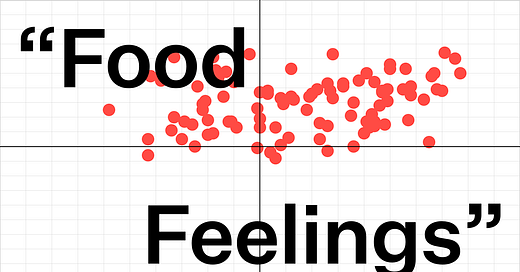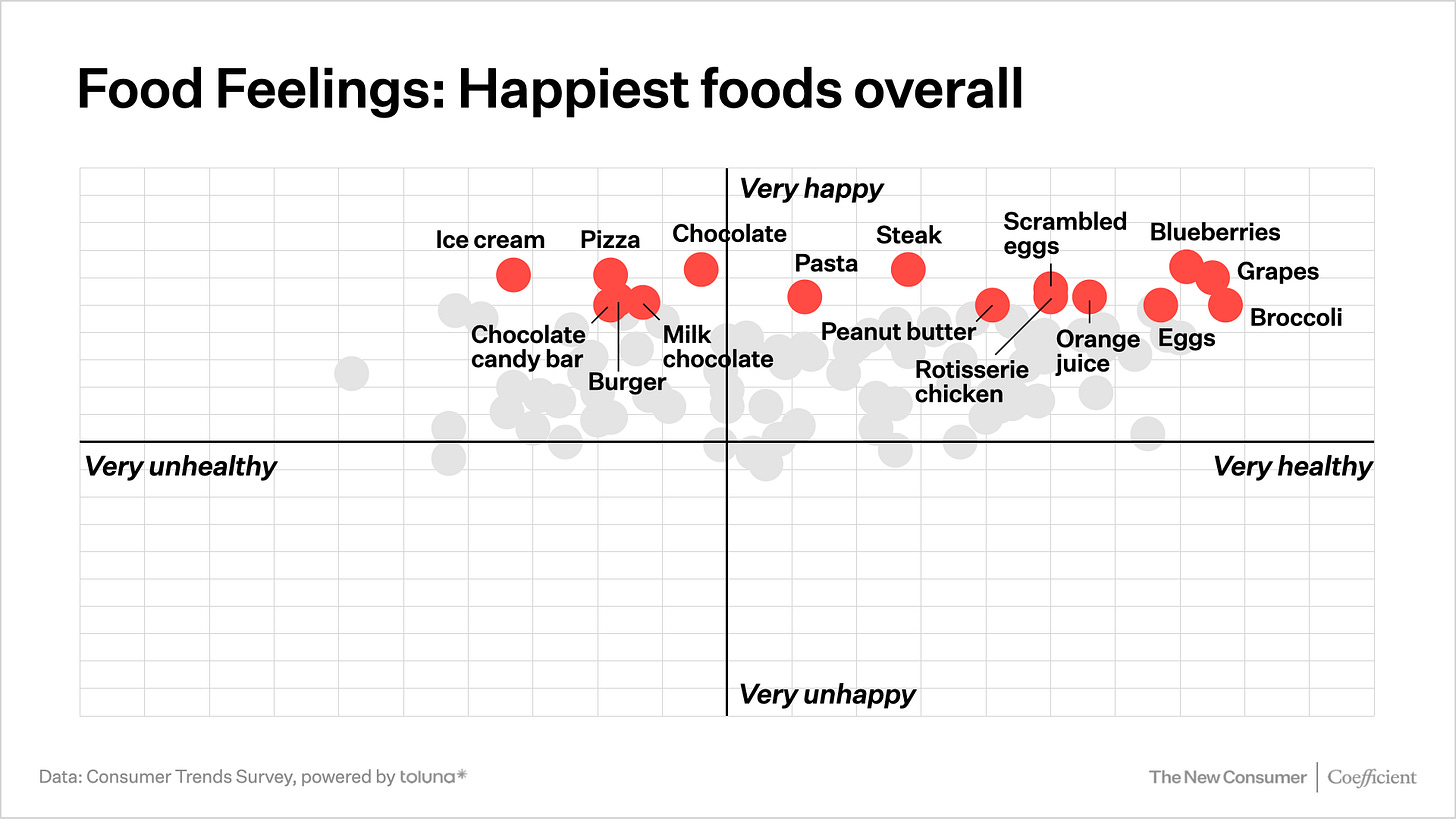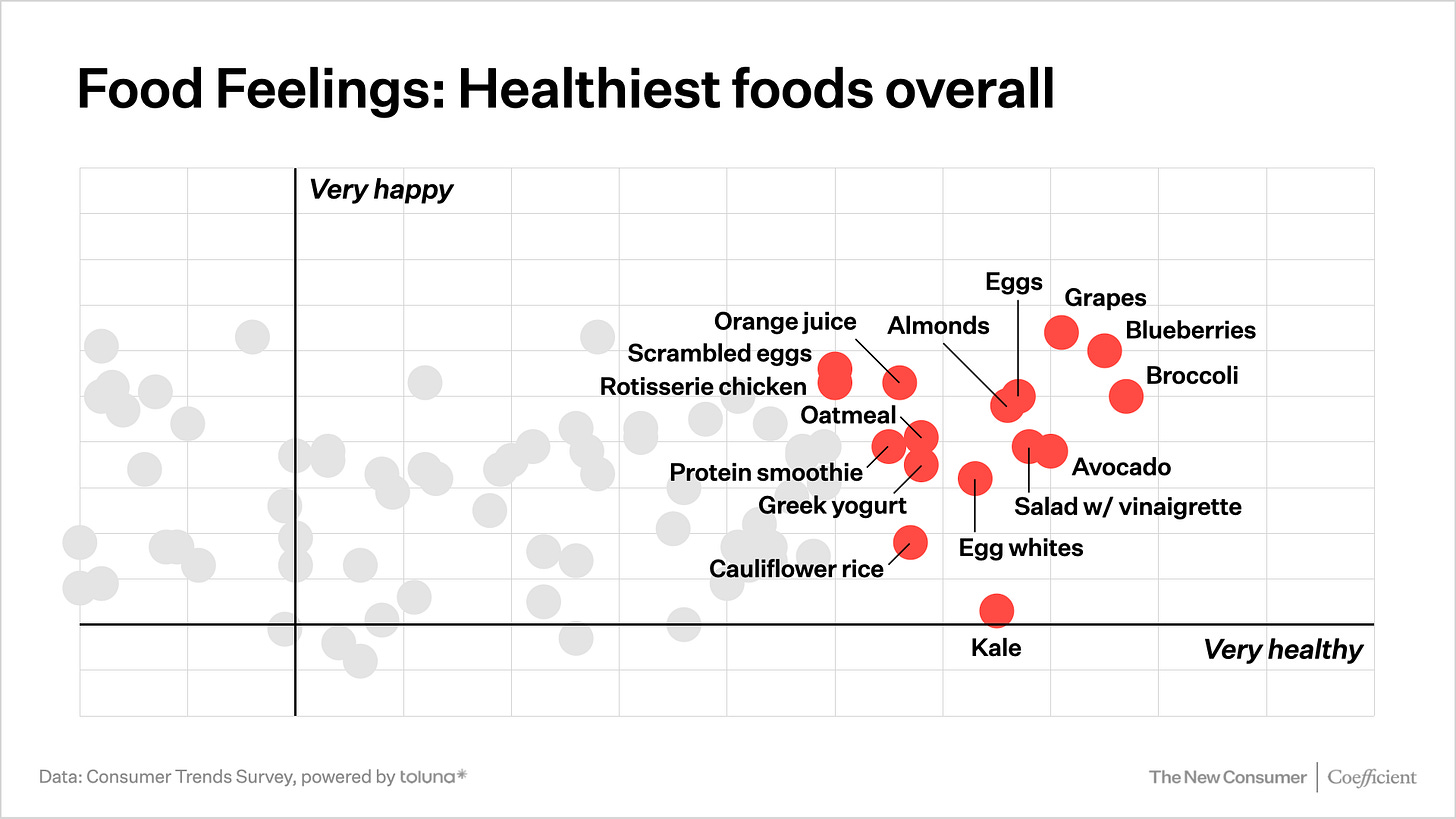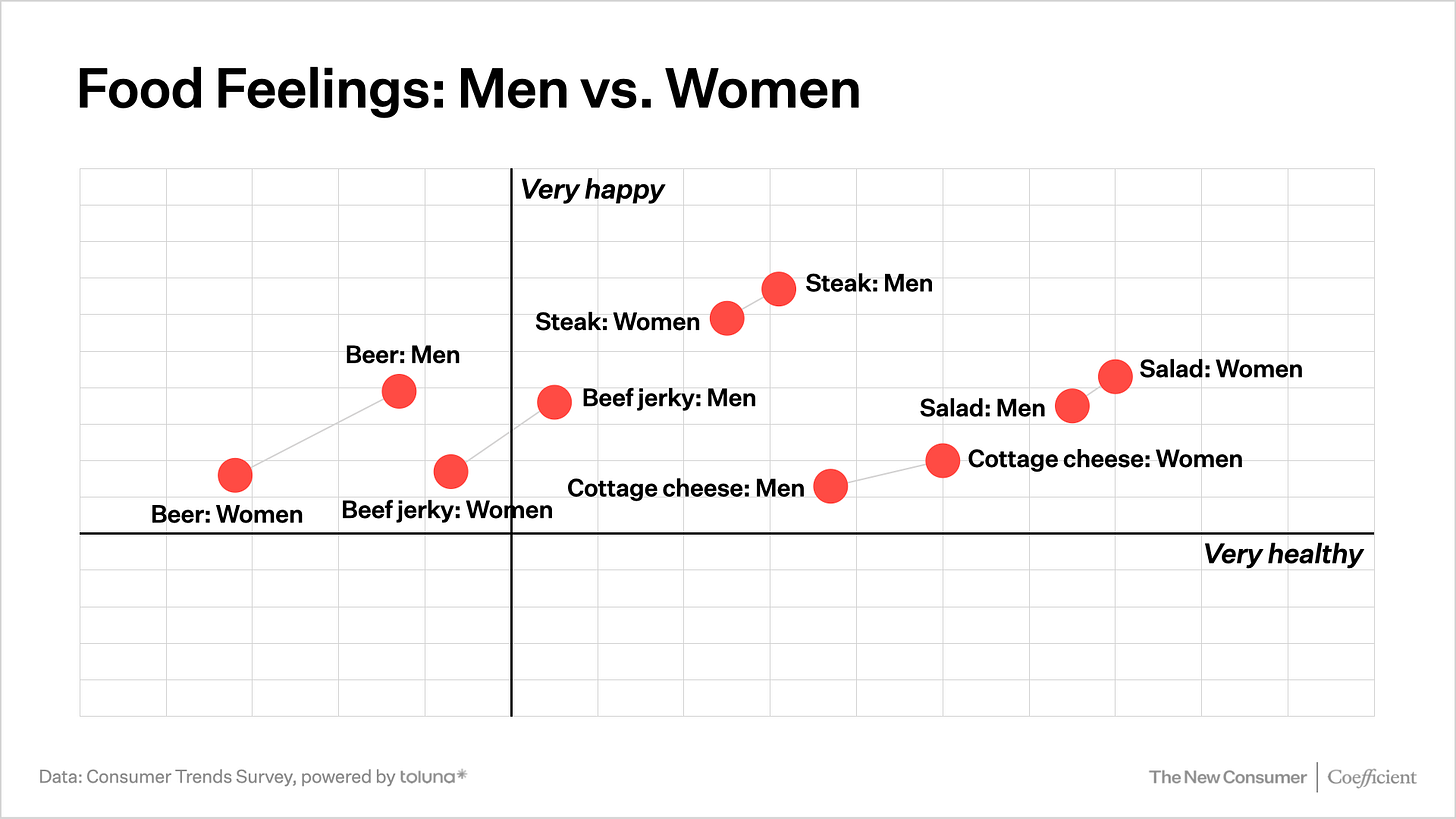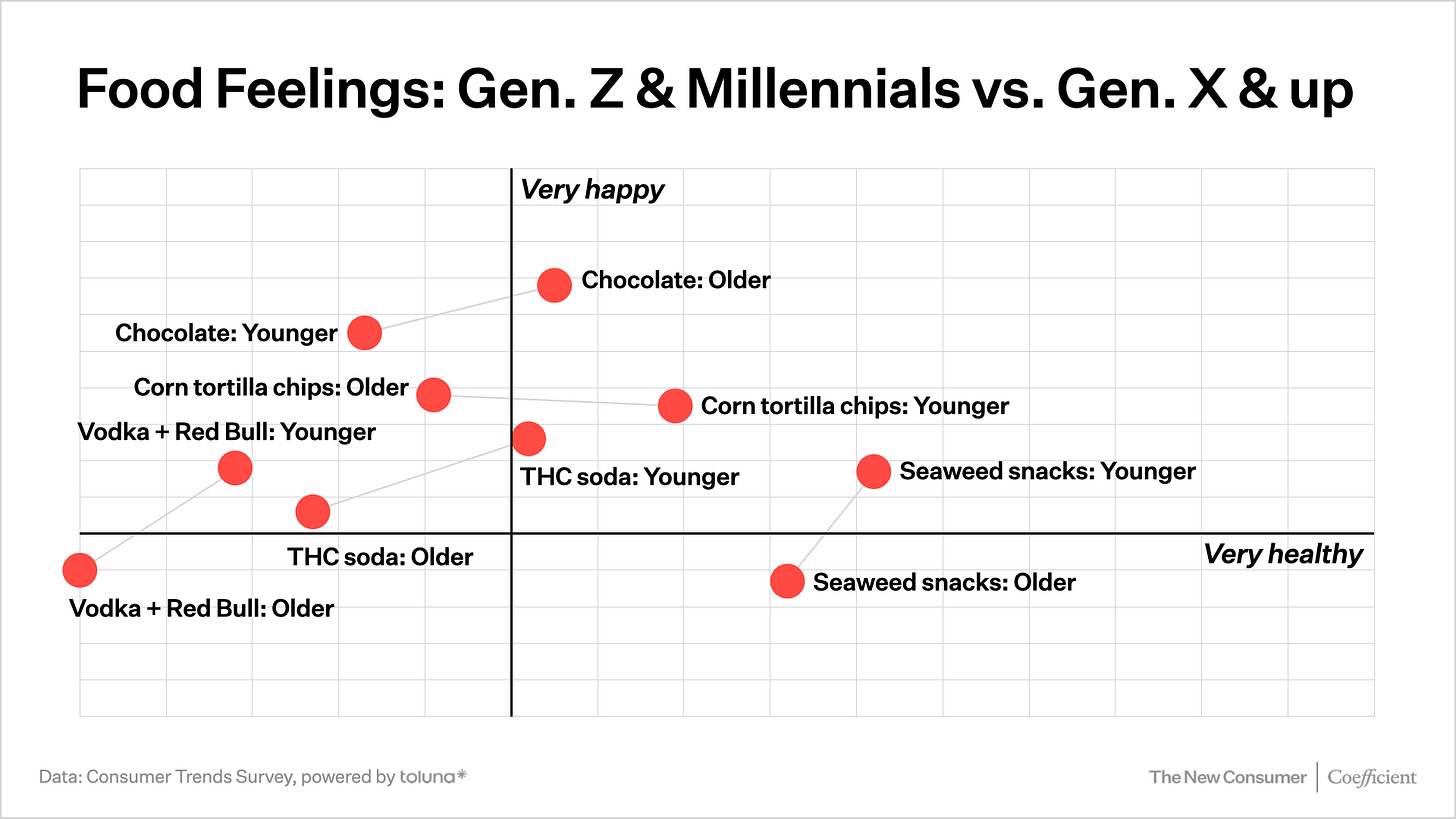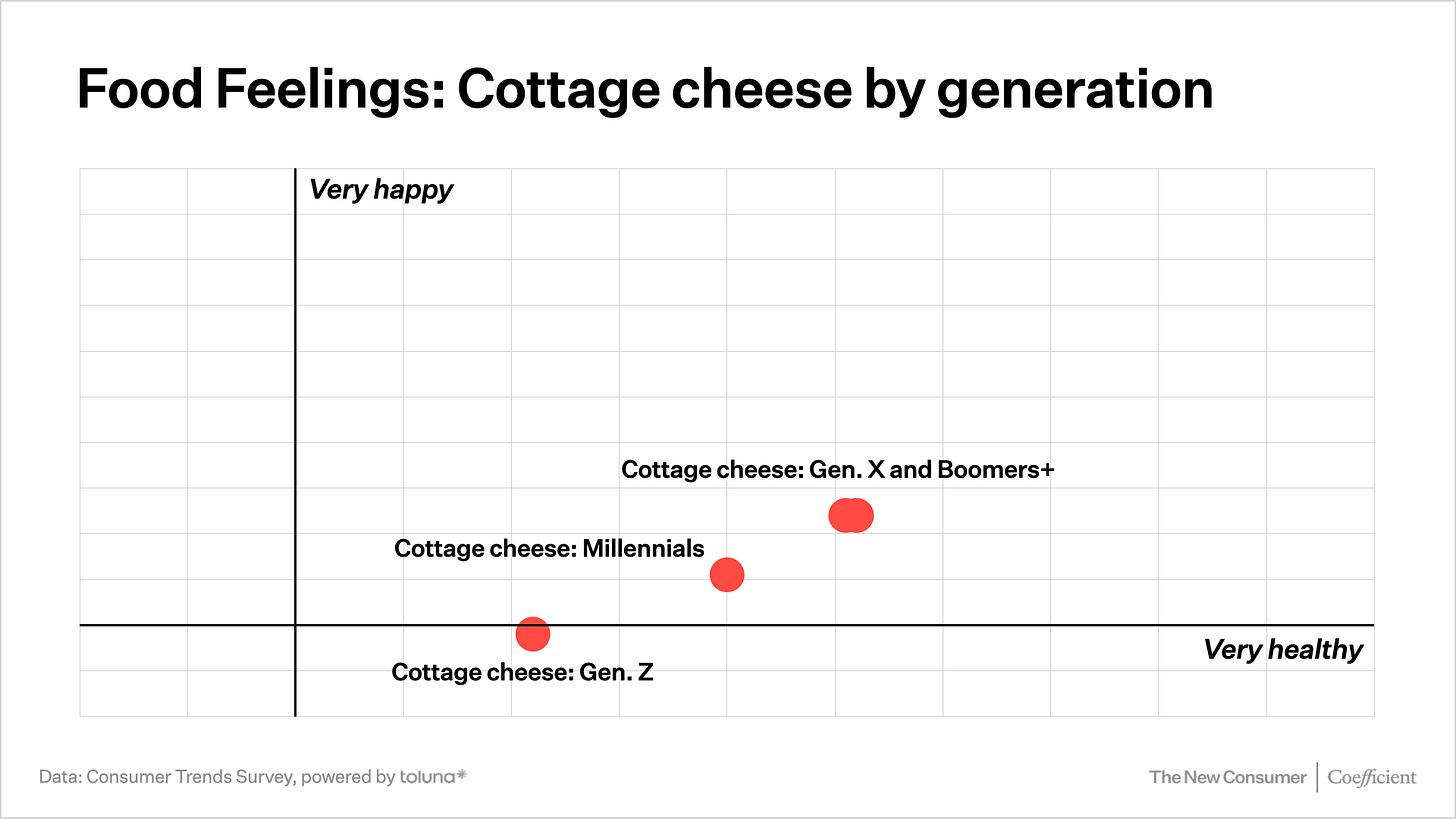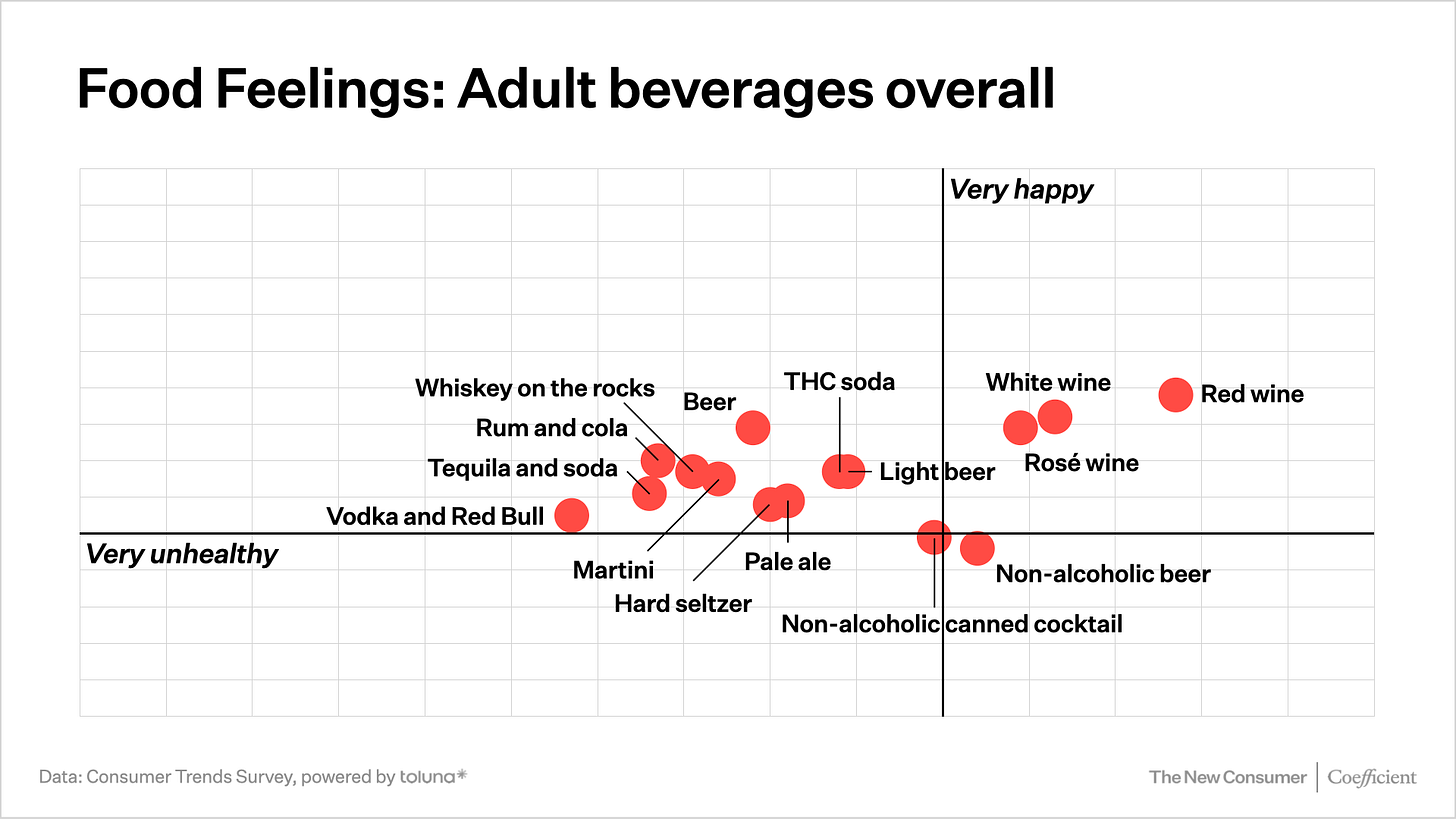Introducing the Consumer Trends Food Feelings Matrix
We asked thousands of Americans to rate 96 food and drinks, from almond butter to whiskey. Here are the healthiest and funnest.
Hello hello! It’s Dan Frommer, back with The New Consumer.
We spend a lot of time here exploring food and beverages that are some mix of: Healthy, increasing in popularity, and innovative in their story, positioning, marketing, packaging, etc.
But food is also fun! Fun to eat, fun to share, and — for many — fun to post about on the internet. It’s important to consider that enjoyment aspect, too.
Most Americans, in our Consumer Trends research, say they try to eat healthy food at least a lot of the time. Most also say it’s important to their mental health to treat themselves with food.
So over the past several months, my research partners at Coefficient Capital and I have asked thousands of US consumers to rate almost 100 food and beverage items — from almond butter to whiskey — in two ways: How healthy they consider them, and how happy it makes them feel to consume them. The results are fascinating.
First, a note from our sponsor: Please join us at the WSJ Global Food Forum next month in Chicago! I’ll be presenting our latest Consumer Trends research on food and wellness, including some cuts from today’s data.
Presented by The WSJ Global Food Forum
Join The Wall Street Journal’s Global Food Forum, June 16–17, 2025, at the Four Seasons Hotel Chicago.
This premier event gathers top executives, investors, policymakers, and innovators across the food and agriculture sectors for a full day of candid interviews and timely conversations.
Explore key topics including dining trends, climate innovation, farm policy, inflation, and investment in breakthrough technologies and products. Connect with influential leaders shaping the future of food — and leave with the insights you need to stay ahead.
As a subscriber of The New Consumer, use code NEWCONSUMER20 at checkout to save 20% off your pass.
Ok, here’s the wide view — 96 food and beverage items plotted on two axes, ranging from “very unhealthy” to “very healthy” and “very unhappy” to “very happy.” We’re calling it the Consumer Trends Food Feelings Matrix.
This is the result of hundreds of thousands of data points: You’re seeing the mean average for each item across our entire survey panel. (Toluna is our Consumer Trends Survey partner and ran these this February and last December.)
We’ve highlighted some outliers, and you can click through to the web version to hover over the rest and see which item is in which place.
The big picture: Most food and beverage items — at least the ones we’ve picked — make people, on average, at least a little happy to consume them.
Only a few items have a negative overall happiness score, and even then, they’re barely negative: Non-alcoholic canned cocktails, plant-based-meat burgers, non-alcoholic beer, diet soda, and the worst overall performer in our list, caviar. (Caviar!? We’ll revisit that in a bit.)
The highest happiness scores are mostly obvious: Chocolate, steak, pizza, and ice cream. But our latest survey uncovered the item that is now our single highest-ranked by happiness: Grapes!
If you isolate the upper-right-most items — those that people, on average, think are both very healthy and make them very happy — three new items are the clear winners: Grapes (highest total score), blueberries, and broccoli, which has the highest total healthiness score and a surprisingly high happiness score. I’m pretty sure blueberries are objectively healthier than grapes, but the people have spoken, and they think grapes are better for you.
Other top scorers here include eggs, almonds, avocado, and salad with a vinaigrette dressing. This chart specifically shows all items that people have rated, on average, “somewhat healthy” to “very healthy.”
Where it starts to get interesting is when you see how different groups of people rate items differently.
Men, for instance, rate many food and beverage items differently than women.
Men, on average, think steak is healthier than women do, and it makes them feel happier to eat it. It’s an even bigger difference with beef jerky, which women, on average, rate mildly unhealthy while men think it’s healthier and makes them happier to eat it.
Both men and women consider beer unhealthy, but men consider it less unhealthy, and it makes them happier. Whiskey, too.
Women, meanwhile, consider cottage cheese healthier than men do, and it makes them happier to eat it. Salad, too.
There are many visible generational differences, too. For the purposes of this analysis and chart, I’ve divided the generations into “younger” (Gen. Z and Millennials) and “older” (Gen. X, Boomers, and Silent).
Younger Americans, for example, find seaweed snacks to be both healthier and more enjoyable. They think cannabis soda (containing THC) is considerably healthier, and it makes them happier. Same for a vodka and Red Bull cocktail.
Younger consumers think corn tortilla chips are healthier than older consumers do, but it makes them a tiny bit less happy to eat them. And older consumers, on average, find chocolate healthier and more enjoyable than younger consumers, who actually consider it modestly unhealthy.
Chocolate actually makes Gen. X happier than any other item makes any other generation.
Here’s one where we can zoom in on a generational level: Cottage cheese, which has been in the news lately, including this WSJ feature story that actually cites (and plots) some of this data from our December 2024 survey.
Gen. Z considers cottage cheese to be a little healthy, but neutral in the happiness scale — slightly negative. Millennials consider it significantly healthier, and slightly more pleasurable to consume. But Gen. X and Boomers+ consider it even healthier and are even happier to eat it.
In our most recent survey, we also asked consumers (age 21+) to rate 15 adult beverages, including different cocktails and spirits, types of beer and wine, non-alcoholic substitutes, and THC soda (which has been growing rapidly in popularity and distribution thanks to a bit of a legal loophole).
Generally, people rate alcoholic drinks as being mildly to moderately unhealthy, while making them feel mildly to moderately happy. People consider wine to be modestly healthy, with red wine considered healthier than either white or rosé. Non-alcoholic cocktails and beer both cross the axis into very slightly “unhappy” territory.
Younger consumers, shown in red dots here, tend to consider the cocktails, spirits, and beer less unhealthy, and wine less healthy, than older consumers, shown in navy blue dots. They also like non-alc substitutes more than older consumers do, and consider THC soda to be (relatively) healthier than any alcoholic drink other than wine.
We can also start to look at more targeted groups, trying to identify trend-setting early adopters — say, Gen. Z and Millennials who live in cities; the Yuppie Index — albeit with smaller sample sizes.
The Yuppie group, on average, rates seaweed snacks, plant-based-meat burgers, and boba tea much higher on the “happier” scale than the overall US consumer. It also considers tequila and soda to be slightly healthy to consume, while the average American considers it modestly unhealthy.
Oh, and caviar. Least fun food on the list! What’s up with that?
We were able to quickly isolate the people who really like caviar — they also love green juice, oat milk, and almond butter. People who love martinis also tend to rate caviar higher on the happiness scale. (A fine pairing — and social signaling!) As do very low and very high earners, though the sample sizes are small.
Speaking of higher earners, those with household incomes over $100k show the biggest happiness uplift for Diet Coke, hummus, and sushi, versus those earning less than $100k.
The most polarizing items on the list — those with the highest concentration of both “very happy” and “very unhappy” votes — include boba tea, THC soda, and hard seltzer. The dullest — where people select “neither happy nor unhappy” at the highest rates — are bone broth and grain-free tortilla chips.
We’re just getting started with this — more to come. (And open to ideas!) I’m also considering making the data available to members; email me if you’re interested in beta testing.
Presented by The WSJ Global Food Forum
Join The Wall Street Journal’s Global Food Forum, June 16–17, 2025, at the Four Seasons Hotel Chicago.
You’ll hear from farmers and food makers about how they’re navigating crisis like new tariffs, bird flu, and inflation.
Chefs, investors, and policymakers will share how they’re pushing boundaries with generative AI and other innovations. And you’ll take away strategies to be a part of the next generation of the food industry.
As a subscriber of The New Consumer, use code NEWCONSUMER20 at checkout to save 20% off your pass.


